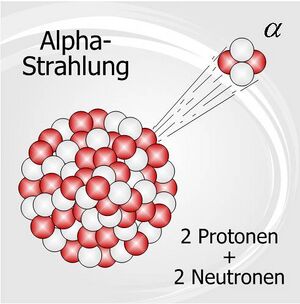Alpha decay
Alpha decay is a case of spontaneous emission of a heavy particle from a radioactive nucleus. By transforming them, the atoms try to reach a more stable state. Alpha decay is the most common case of transformation. In addition to alpha decay, beta decay and spontaneous nuclear fission also occur.
Alpha conversion is only encountered in heavy natural radionuclides. An alpha particle is composed of two protons and two neutrons, so it is the nucleus of the element helium. Due to the presence of two protons, the particle carries two positive elementary charges. The energy spectrum of the given radiation is linear.
When a particle is emitted, the parent nucleus is transformed, the proton number Z decreases by 2, the nucleon number A decreases by 4, the helium nucleus is released (A = 4, Z = 2). The result of the transformation is a daughter nucleus, which is two places to the left of the parent nucleus in Mendeleev's periodic table of elements. The kinetic energy of the nucleus is negligible during emission, it is lower for the emitted particle.
When passing through the environment, alpha particles strongly ionize and excite, quickly losing their energy. This fact determines the limited range of alpha radiation. Alpha radiation is not very penetrating, the penetration in air is a few millimeters, in water fractions of a millimeter. Upon contact with the skin, it is absorbed in the upper layers of the skin. Alpha radiation is therefore dangerous only in case of internal contamination of the organism. Protection from radiation is a sheet of paper or clothing, or even a thin Plexiglas foil.
Links[edit | edit source]
[edit | edit source]
References[edit | edit source]
- BENEŠ, Jiří. Fundamentals of Medical Biophysics. 3. edition. Karolinum, 2011. 200 pp. ISBN 978-80-246-2034-3.
- ROSINA, Jozef – KOLÁŘOVÁ, Hana. Biophysics for medical students. 1. edition. Grada, 2006. ISBN 80-247-1383-7.
- NAVRÁTIL, Leoš – ROSINA, Jozef. Medical Biophysics. 1. edition. Grada, 2005. 524 pp. ISBN 80-247-1152-4.

